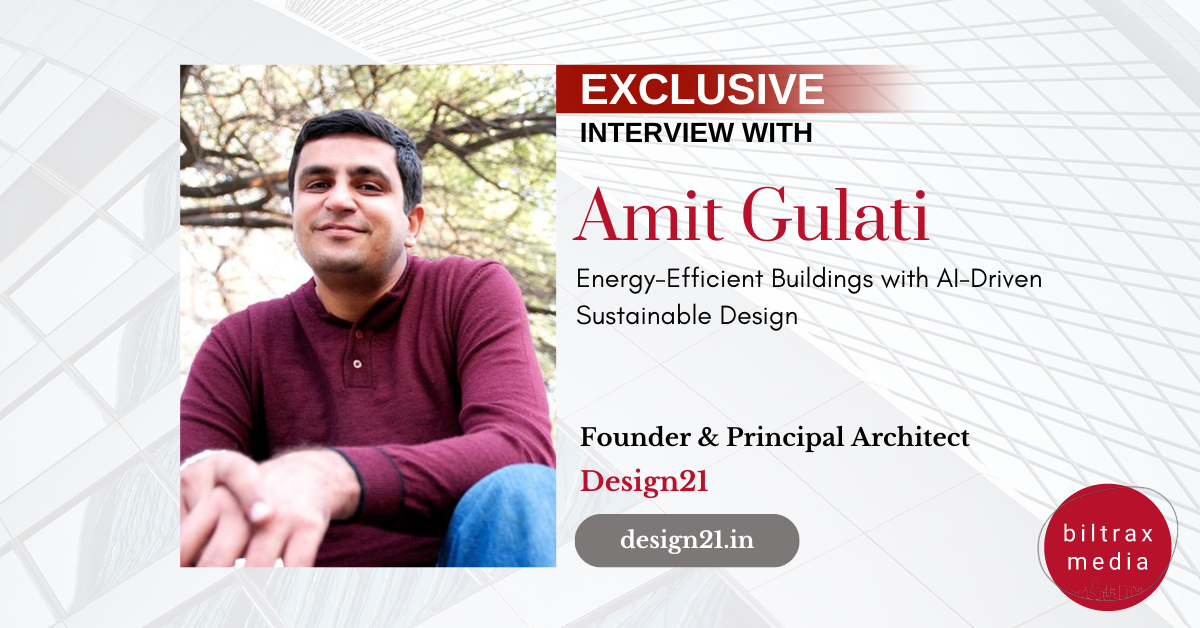The task of building sustainable and aesthetically pleasing structures has always been a challenge for the construction industry for decades. But what if ingenious engineering or superior materials were not the only solutions? Artificial intelligence (AI) technology holds the key to the solution as it is revolutionizing the way to approach energy management and building design. Artificial Intelligence (AI) is enabling a new age of energy-efficient buildings through its capacity to analyze volumes of data and make well-informed judgments. Ar. Amit Gulati, Founder and Principal Architect at Design21, through this article, explores the fusion of sustainable design and AI and how this amalgamation will shape the future of architecture.
Using AI to Improve Energy Efficiency
Real-time data analysis, pattern recognition, and predictive recommendation are all enabled by AI-powered systems, which optimize energy use. Building owners and operators can decrease energy waste by identifying inefficiencies. They can gain useful insights into their energy usage patterns and implement targeted tactics by utilizing AI algorithms. Furthermore, AI provides a variety of tools and strategies to maximize energy efficiency and minimize environmental impact. These range from demand response optimization to predictive maintenance.

Systems for Smart Building Management
AI is used by smart building systems to save energy as it gathers sensor data and modifies ventilation, heating, cooling, and lighting. This maximizes energy efficiency without compromising occupant comfort. Intelligent systems play a crucial role in sustainable building design by continuously evaluating performance and modifying operations. To maximize energy efficiency and lower operating costs, these systems may also adjust to changing conditions, such as occupancy patterns and weather forecasts.

AI for Predictive Design
Predictive maintenance is another important aspect that uses AI in sustainable design. Its goal is to find and fix possible equipment problems before they occur. AI algorithms can identify trends pointing to imminent equipment breakdowns. It can further send prediction alerts to maintenance staff by analyzing sensor readings and performance indicators. By using a proactive approach, building systems showcase less downtime and an increased lifespan. Predictive maintenance guarantees that building systems function at maximum efficiency. This lowers energy consumption and operating costs in the process by addressing maintenance concerns aptly and effectively.

Stimulating and Modelling Energy
AI-powered energy modeling and simulation tools give architects and designers crucial insights into the energy efficiency of their structures. These technologies use complex algorithms to analyze systems, materials, and building designs to simulate their behavior under various conditions. To save energy, designers can optimize building orientation, use passive design strategies, and use energy-efficient materials and technology. By using AI-driven energy modeling in the design process, architects and designers can create visually appealing, incredibly energy-efficient, and sustainable structures.
Designing and managing energy in buildings is evolving as a result of the application of AI in sustainable design methods. Energy-efficient and eco-friendly building construction is now increasingly dependent on artificial intelligence. So let us develop a built sustainable environment, fulfills the requirements of coming generations, and conserve the environment by utilizing its potential!
Design21
Website: https://design21.in/
Email Id: info@design21.in

Biltrax Construction Data is tracking 30,000+ projects on their technology platform for their clients.
Get exclusive access to upcoming projects in India with actionable insights. Furthermore, gain a competitive advantage for your products in the Indian Construction Market.
Visit www.biltrax.com or email us at contact@biltrax.com to become a subscriber and generate leads.
Disclaimer: The information herein is based upon information obtained in good faith from sources believed to be reliable. All such information and opinions can be subject to change. Furthermore, The image featured in this article is for representation purposes only. It does not in any way represent the project. If you wish to remove or edit the article, please email editor@biltrax.com.
Discover more from Biltrax Media, A Biltrax Group venture
Subscribe to get the latest posts sent to your email.






















